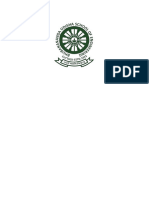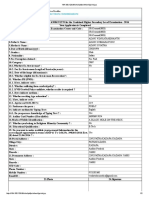Fiber-Reinforced Concrete
Fiber-Reinforced Concrete
Uploaded by
Venkata HemanthCopyright:
Available Formats
Fiber-Reinforced Concrete
Fiber-Reinforced Concrete
Uploaded by
Venkata HemanthOriginal Description:
Original Title
Copyright
Available Formats
Share this document
Did you find this document useful?
Is this content inappropriate?
Copyright:
Available Formats
Fiber-Reinforced Concrete
Fiber-Reinforced Concrete
Uploaded by
Venkata HemanthCopyright:
Available Formats
Fiber reinforced concrete
Fiber-reinforced
concrete
(FRC)
is
concrete containing fibrous material which
increases its structural integrity. It contains
short discrete fibers that are uniformly
distributed and randomly oriented. Fibers
include steel fibers, glass fibers, synthetic
fibers and natural fibers each of which lend
varying properties to the concrete. In
addition, the character of fiber-reinforced
concrete changes with varying concretes,
fiber materials, geometries, distribution,
orientation, and densities.
Historical perspective
The concept of using fibers as reinforcement
is not new. Fibers have been used as
reinforcement
since
ancient
times.
Historically, horsehair was used in mortar
and straw in mud bricks. In the 1900s,
asbestos fibers were used in concrete. In the
1950s, the concept of composite materials
came into being and fiber-reinforced
concrete was one of the topics of interest.
Once the health risks associated with
asbestos were discovered, there was a need
to find a replacement for the substance in
concrete and other building materials. By the
1960s, steel, glass (GFRC), and synthetic
fibers such as polypropylene fibers were
used in concrete. Research into new fiberreinforced concretes continues today.
Effect of fibers in concrete
Fibers are usually used in concrete to control cracking
due to plastic shrinkage and to drying shrinkage. They
also reduce the permeability of concrete and thus reduce
bleeding of water. Some types of fibers produce greater
impact, abrasion, and shatterresistance in concrete.
Generally fibers do not increase the flexural strength of
concrete, and so cannot replace momentresisting or
structural steel reinforcement. Indeed, some fibers
actually reduce the strength of concrete.
The amount of fibers added to a concrete mix is
expressed as a percentage of the total volume of the
composite (concrete and fibers), termed "volume
fraction" (Vf). Vf typically ranges from 0.1 to 3%. The
aspect ratio (l/d) is calculated by dividing fiber length (l)
by its diameter (d). Fibers with a non-circular cross
section use an equivalent diameter for the calculation of
aspect ratio. If the fiber's modulus of elasticity is higher
than the matrix (concrete or mortar binder), they help to
carry the load by increasing the tensile strength of the
material. Increasing the aspect ratio of the fiber usually
segments the flexural strength and toughness of the
matrix. However, fibers that are too long tend to "ball" in
the mix and create workability problems.
Some recent research[where?] indicated that using fibers in
concrete has limited effect on the impact resistance of
the materials.[1][2] This finding is very important since
traditionally, people think that ductility increases when
concrete is reinforced with fibers. The results also
indicated that the use of micro fibers offers better impact
resistance to that of longer fibers.[1]
The High Speed 1 tunnel linings incorporated concrete
containing 1 kg/m of polypropylene fibers, of diameter
18 & 32 m, giving the benefits noted below.[1]
As for pavements, the most prevalent use for FRC is at
toll plazas where nonmetallic fibers are used in lieu of
metallic reinforcement since they can disrupt electronic
toll readers signals.
APPLICATIONS
APPLICATIONS AND FIBER TYPES
Fiber Reinforced Concrete (FRC) is one of the
fastest growing segments in the concrete industry
as more and more engineers, architects, owners,
specifiers and concrete contractors are turning to
the use of fibers to supply their reinforcing needs in
their concrete applications. Technical Resources,
such as the American Concrete Institute (ACI),
have published guidelines and recommendations
into the proper specification and use of FRC.
The following Applications and Types of Fibers for
use in FRC are consistent with the searchable
database found in this web-site. When using the
database, it may be necessary to use keywords,
as shown below, to narrow a search for a particular
application. As an example, you may find stamped,
colored concrete on a highway application. All of
the Application types below may be constructed
with the use of fiber reinforced concrete.
Potential projects suited to the use of fiber
reinforced concrete are listed below. Where
possible, the members of the FRCA have submitted
project profiles with the use of fibers in the following
applications in the PROJECTS section of this
web-site.
1
Fiber reinforced concrete
Residential: including driveways, sidewalks, pool
construction with shotcrete, basements, colored
concrete, foundations, drainage, etc.
Commercial: exterior and interior floors, slabs and
parking areas, roadways and
Warehouse / Industrial: light to heavy duty loaded
floors and roadways
Highways / Roadways / Bridges: conventional
concrete paving, SCC, white-toppings, barrier rails,
curb and gutter work, pervious concrete, sound
attenuation barriers, etc.
Ports and Airports: runways, taxiways, aprons,
seawalls, dock areas, parking and loading ramps.
Waterways: dams, lock structures, channel linings,
ditches, storm-water structures, etc.
Mining and Tunneling: Precast segments and
schotcrete, which may include tunnel lining, shafts,
slope stabilization, sewer work, etc.
Elevated Decks: including commercial and
industrial composite metal deck construction and
elevated formwork at airports, commercial
buildings, shopping centers, etc.
Agriculture: farm and animal storage structures,
walls, silos, paving, etc.
Precast Concrete and Products: architectural
panels, tilt-up construction, walls, fencing, septic
tanks, burial vaults, grease trap structures, bank
vaults and sculptures
Other Applications: includes any other FRC
related applications not specifically described
above.
FIBER TYPES
Fiber types for use in FRC Applications come in
many sizes, shapes, colors and flavors. Please
contact the various manufacturers, listed in the
CONTACT US section for additional technical
literature and dosage recommendations.
Steel Fibers: These fibers are generally used for
providing concrete with enhanced toughness and
post-crack load carrying capacity. Typically loose or
bundled, these fibers are generally made from
carbon or stainless steel and are shaped into
varying geometries such as crimped, hooked-end
or with other mechanical deformations for
anchorage in the concrete. Fiber types are
classified within ACI 544 as Types I through V and
have maximum lengths ranging from 1.5 to 3 (30
80 mm) and can be dosed at 10 to 100 lbs/yd (6
to 67 kg/m3).
Micro-synthetic fibers: These fibers are generally
used for the protection and mitigation of plastic
shrinkage cracking in concrete. Most fiber types are
manufactured from polypropylene, polyethylene,
polyester, nylon and other synthetic materials such
as carbon, aramid and other acrylics. These fiber
types are generally dosed at low volumes ranging
from 0.03 to 0.2% by volume of concrete 0.5 to
3.0 lbs/yd (0.3 to 0.9 kg/m3).
Macro-synthetic fibers: This newer class of fibers
has emerged over the past 15 years as a suitable
alternate to steel fibers when dosed properly.
Typical materials include polypropylene and other
polymer blends having the same physical
characteristics as steel fibers (length, shape, etc.),
These fibers can be dosed from 3 to 20 lbs/yd (1.8
to 12 kg/m3).
Glass Fibers: GFRC (Glass Fiber Reinforced
Concrete) has been predominantly used in
architectural applications and modified cement
based panel structures.
Cellulose Fibers: manufactured from processed
wood pulp products, cellulose fibers are used in a
similar manner to micro-synthetic fibers for the
control and mitigation of plastic shrinkage cracking.
Natural Fibers: Not typically used in commercial
applications of fiber reinforced concrete, natural
fibers are used to reinforce cement based products
in applications around the world and include
materials such as coconut, sisal, jute and
sugarcane. These materials come in varying
lengths, geometries and material characteristics.
PVA Fibers: Poly-vinyl alcohol fibers are synthetic
made fibers that when used at higher volumes, can
alter the flexural and compressive performance of
concrete
Specialty Fibers: This classification of fibers
covers materials not described above and generally
pertains to newly manufactured or specified
materials not common to the above categories.
Steel & Micro / Macro blends: A recent
development in the field of fiber reinforced concrete
that has emerged in the marketplace has been the
combination or blending of steel and / or macrosynthetic fibers with various types of micro-fibers to
2
Fiber reinforced concrete
help control plastic shrinkage cracking (ie: microsynthetics) while at the same time providing
concrete with enhanced toughness and post-crack
load carrying capacity achieved only with the use of
steel and macro-synthetic fibers. These fibers are
typically dosed at the prevailing
Other Fibers and Blends: Combinations and types
of fibers not classified above
You might also like
- A Comprehensive Guide to Composites: Processes & Procedures from the ProfessionalsFrom EverandA Comprehensive Guide to Composites: Processes & Procedures from the Professionals5/5 (2)
- TOS 3 Unit 1 Fixed Beams & Continuous Beams and Torsion100% (2)TOS 3 Unit 1 Fixed Beams & Continuous Beams and Torsion19 pages
- Computer Networks With Internet Technology William StallingsNo ratings yetComputer Networks With Internet Technology William Stallings60 pages
- Aijaz Report Advanced Buiding MaterialsNo ratings yetAijaz Report Advanced Buiding Materials14 pages
- Fibre Reinforced CONCRETE - PPTX: Historical DevelopmentNo ratings yetFibre Reinforced CONCRETE - PPTX: Historical Development14 pages
- Effect of Fibers in Concrete Composites: International Journal of Applied Engineering Research January 2015No ratings yetEffect of Fibers in Concrete Composites: International Journal of Applied Engineering Research January 201513 pages
- Body of The Content Pagenumber Inputed 123No ratings yetBody of The Content Pagenumber Inputed 12382 pages
- Reference 101. Effect of Fibers in Concrete CompositesNo ratings yetReference 101. Effect of Fibers in Concrete Composites13 pages
- Enhancement The Strength of Conventional Concrete by Using Nylon FibreNo ratings yetEnhancement The Strength of Conventional Concrete by Using Nylon Fibre4 pages
- Project Report On Polymer Fibre Reinforced Concrete Pavements82% (17)Project Report On Polymer Fibre Reinforced Concrete Pavements41 pages
- An Investigation On Design Procedure and Operations of Polymer Fibre Reinforced Concrete Pavements by S. Panda & N.H.S.rayNo ratings yetAn Investigation On Design Procedure and Operations of Polymer Fibre Reinforced Concrete Pavements by S. Panda & N.H.S.ray12 pages
- CE3013 Advanced Construction TechniquesNo ratings yetCE3013 Advanced Construction Techniques87 pages
- Fiber-Reinforced Concrete - Advantages, Types and ApplicationsNo ratings yetFiber-Reinforced Concrete - Advantages, Types and Applications8 pages
- Presenting: Sri Venkateswara Engineering CollegeNo ratings yetPresenting: Sri Venkateswara Engineering College18 pages
- Fibre Reinforced Concrete FRC Ijariie4483No ratings yetFibre Reinforced Concrete FRC Ijariie44837 pages
- Fiber Reinforced Concrete: Max Kipchumba Faith Neema Bob Calleb Ernest Koyoo 1. 2. 3. 4No ratings yetFiber Reinforced Concrete: Max Kipchumba Faith Neema Bob Calleb Ernest Koyoo 1. 2. 3. 419 pages
- Advanced Construction Techniques Equipment 6th SemNo ratings yetAdvanced Construction Techniques Equipment 6th Sem89 pages
- Fibre Reinforced Concrete-A Case Study: November 2017No ratings yetFibre Reinforced Concrete-A Case Study: November 201716 pages
- Glass Fibre Concrete: Investigation On Strength and Fire Resistant PropertiesNo ratings yetGlass Fibre Concrete: Investigation On Strength and Fire Resistant Properties5 pages
- Fibre Reinforced Concrete: A Consise ReportNo ratings yetFibre Reinforced Concrete: A Consise Report5 pages
- Seminar Report On Fiber Rainforced Concrete90% (10)Seminar Report On Fiber Rainforced Concrete48 pages
- Seminar Report On Fiber Rainforced Concrete100% (1)Seminar Report On Fiber Rainforced Concrete48 pages
- Review of Literature: (Citation Leo13 /L 1033) (CITATION Jon15 /L 1033)No ratings yetReview of Literature: (Citation Leo13 /L 1033) (CITATION Jon15 /L 1033)5 pages
- Steel Fibre Concrete Composites For Special Applications100% (3)Steel Fibre Concrete Composites For Special Applications213 pages
- Sustainability in Structural Concrete DesignFrom EverandSustainability in Structural Concrete DesignJorge de BritoNo ratings yet
- A Database Is A Collection of Data That Is Stored in An Organized MannerNo ratings yetA Database Is A Collection of Data That Is Stored in An Organized Manner3 pages
- IV B.tech - II Sem. R10 Autonomous Regular April 2015No ratings yetIV B.tech - II Sem. R10 Autonomous Regular April 201517 pages
- Software Testing Methodologies Course Page: Paths, Path Products and Regular ExpressionsNo ratings yetSoftware Testing Methodologies Course Page: Paths, Path Products and Regular Expressions37 pages
- At The End of This Unit, The Student Will Be Able To:: Transaction Flow Testing and Data Flow TestingNo ratings yetAt The End of This Unit, The Student Will Be Able To:: Transaction Flow Testing and Data Flow Testing23 pages
- Order Confirmation: Booking Code: 8Zhjbw2NNo ratings yetOrder Confirmation: Booking Code: 8Zhjbw2N1 page
- M.Chandrkanth: E-Mail:-Mobile: - Career ObjectiveNo ratings yetM.Chandrkanth: E-Mail:-Mobile: - Career Objective2 pages
- Beams With Uniform Load and End Moments of Reinforced Concrete in Mathcad Prime 6.0.0 PDFNo ratings yetBeams With Uniform Load and End Moments of Reinforced Concrete in Mathcad Prime 6.0.0 PDF9 pages
- Analysis and Design of Open Web Steel Joist-Girders100% (1)Analysis and Design of Open Web Steel Joist-Girders45 pages
- Detailed Estimate: Sl. No. Items No L B D Qty UnitNo ratings yetDetailed Estimate: Sl. No. Items No L B D Qty Unit2 pages
- Details of Wall Footing: Proposed Two-Storey Residential Mr. & Mrs. Julius Cesar ClaravallNo ratings yetDetails of Wall Footing: Proposed Two-Storey Residential Mr. & Mrs. Julius Cesar Claravall1 page
- Cantilevered Sheet Pile Walls in Sandy Soil CalculatorNo ratings yetCantilevered Sheet Pile Walls in Sandy Soil Calculator1 page
- Calcul Des Structures Acier: Norme: Type D'AnalyseNo ratings yetCalcul Des Structures Acier: Norme: Type D'Analyse2 pages
- Interim Revisions To: The Manual For Bridge EvaluationNo ratings yetInterim Revisions To: The Manual For Bridge Evaluation57 pages
- Jobaid1 Inspection Checklist For Wood Frame Shear WallsNo ratings yetJobaid1 Inspection Checklist For Wood Frame Shear Walls2 pages
- Isolated Footing Design Example and Excel SheetNo ratings yetIsolated Footing Design Example and Excel Sheet8 pages
- Comparison of Different Numerical Models of RC EleNo ratings yetComparison of Different Numerical Models of RC Ele18 pages
- Perhitungan Stabilitas Pondasi Bored Pile Pada Proyek Double-Double TrackNo ratings yetPerhitungan Stabilitas Pondasi Bored Pile Pada Proyek Double-Double Track10 pages
- Technical Information Schoeck Isokorb T For Reinforced Concrete Structures Fire Protection (7277)No ratings yetTechnical Information Schoeck Isokorb T For Reinforced Concrete Structures Fire Protection (7277)4 pages
- Strength Analysis of Reinforced Concrete Columns: Interaction With ChartNo ratings yetStrength Analysis of Reinforced Concrete Columns: Interaction With Chart7 pages






































































































